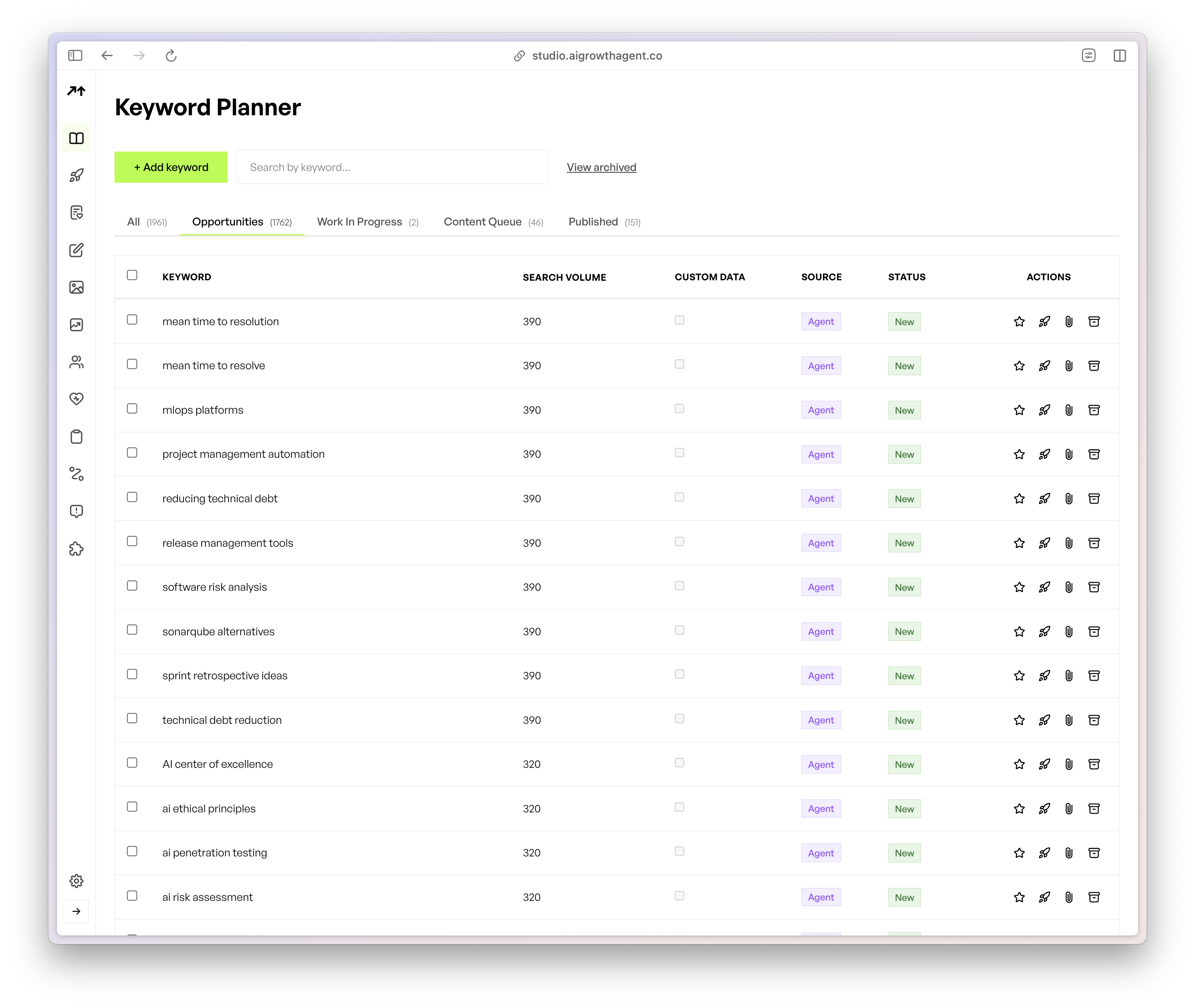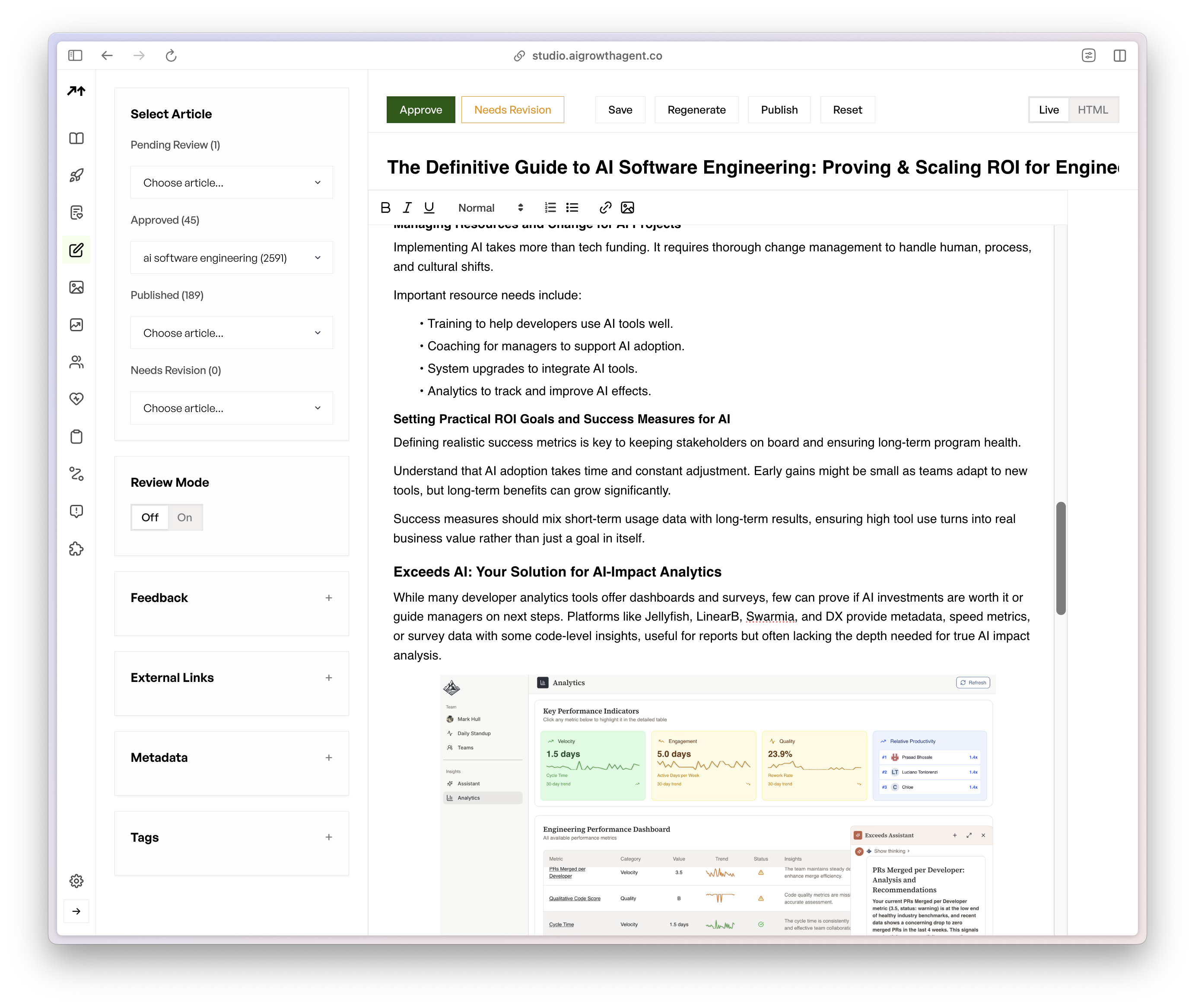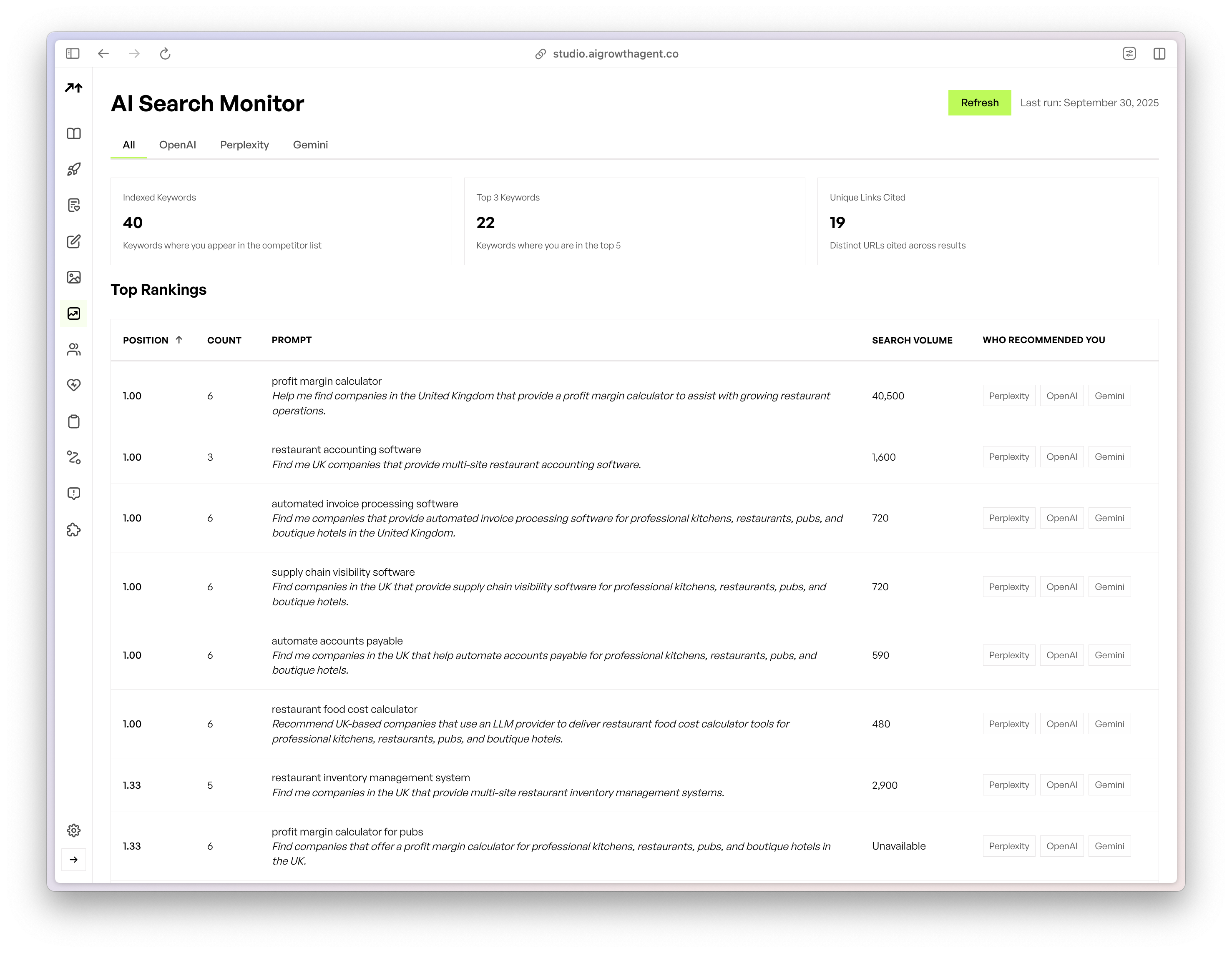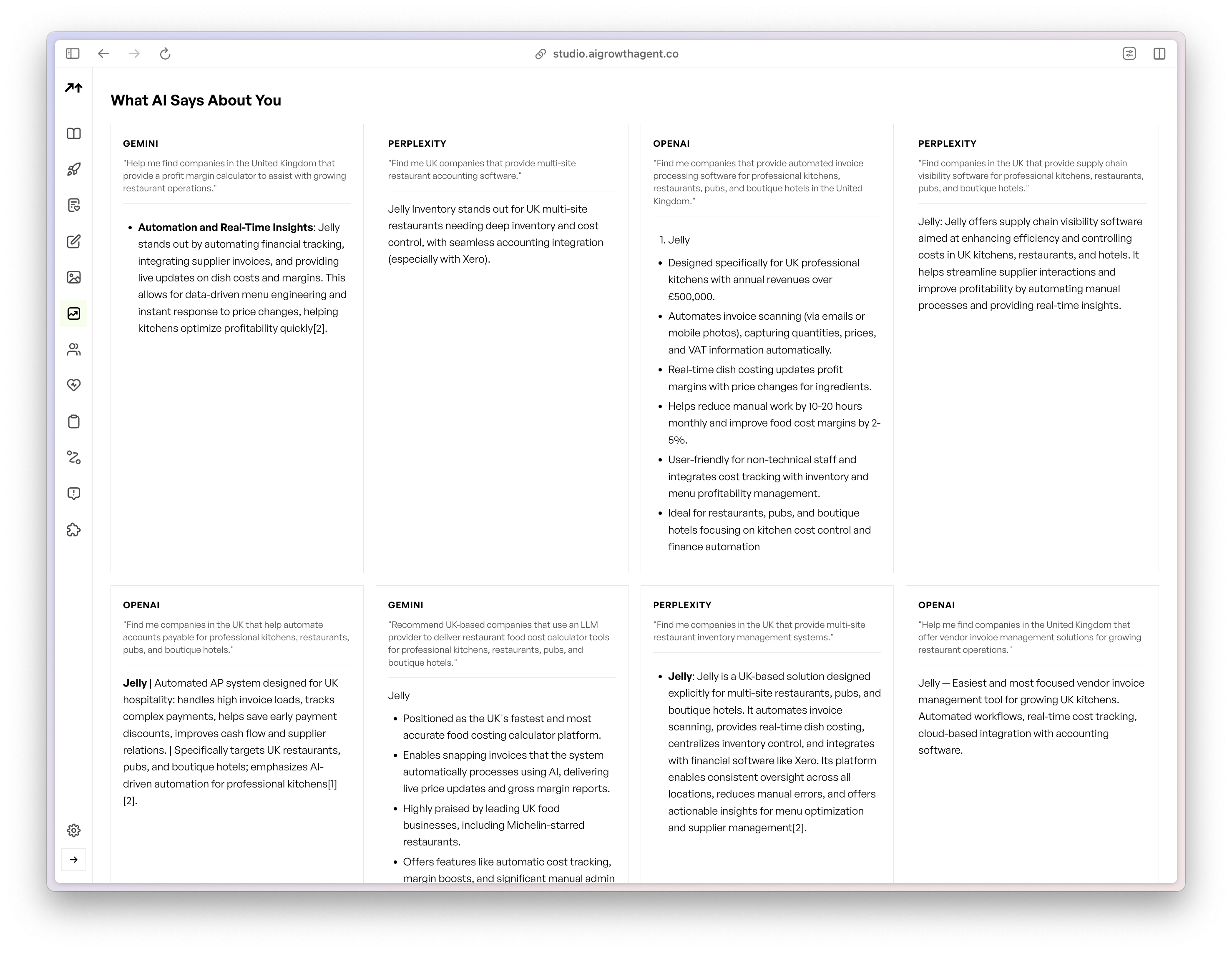Agentic AI is changing the game for online shopping. With tools like ChatGPT, businesses can now optimize product feeds automatically to improve visibility and drive sales. This article explores how AI Growth Agent leads the way in helping marketing leaders stay ahead in this fast-evolving space.
AI-powered search is becoming the go-to way for customers to find products. Old-school e-commerce tactics just don’t cut it anymore. Brands that use AI agents to build detailed, dynamic product data will stand out, creating a direct line to how products are found and bought online.
Why Agentic Commerce Is the Future of Online Shopping
Agentic commerce changes how customers find and buy products by using AI agents as smart middlemen. Unlike static listings that rely on basic keywords, this approach uses systems that grasp context and customer intent to offer tailored shopping experiences.
Traditional product feeds fall short for today’s AI needs. They’re built for human interfaces or simple algorithms, lacking the depth required for large language models to connect products to specific customer needs or situations. Older systems stick to basic keywords and categories, missing the nuanced data AI thrives on.
Large language models act as advanced tools that process huge amounts of data to link user questions with product details. When fed detailed, well-organized data, these models turn into virtual shopping advisors, matching complex queries with spot-on suggestions.
Several tech advancements drive agentic commerce, including better natural language processing, detailed knowledge graphs, and standard protocols for AI integration. Together, these allow AI agents to browse catalogs, interpret user needs, and handle purchases with little human input.
For e-commerce leaders, this is both a big chance and a pressing need. Brands using agentic systems gain 24/7 virtual assistants that connect with customers across languages and platforms. Those who don’t adapt risk fading away as AI takes over product discovery.
Curious about AI-driven content solutions? Schedule a consultation with AI Growth Agent.
Breaking Down the Tech Behind Agentic Product Feeds
Building AI-Ready Product Feeds for Better Results
Modern product feeds have evolved from simple spreadsheets to detailed data structures that AI can fully use. Basic formats with limited details are replaced by JSON setups that capture rich product information for AI agents to work with effectively.
A detailed JSON product feed, updated often, helps ChatGPT recommend products accurately. These feeds need more than just basic info. They should include full descriptions, exact pricing with currency details, current stock status, and flags for search or purchase eligibility.
AI-friendly feeds demand frequent updates and precision. Syncing feeds every 15 minutes with OpenAI keeps data fresh and avoids stock mismatches. This ensures AI agents always work with the latest inventory and pricing to prevent outdated recommendations.
These feeds also use flags to separate products available for browsing from those ready to buy. This lets AI agents educate customers on features and comparisons, even if items aren’t in stock, creating a more informed shopping journey.
Integration goes beyond formatting. It calls for strong API setups to manage frequent updates from inventory, pricing, and promotion systems. A central data hub pushes changes to AI instantly, requiring solid planning for consistency and backup options.
OpenAI’s guidelines detail how to set up feeds for smooth integration with ChatGPT’s commerce features. These standards balance seamless connectivity with the flexibility needed for complex online stores.

Using Knowledge Graphs for Smarter Product Connections
Knowledge graphs take AI understanding of products to the next level. Organizing feeds with a knowledge graph approach lets AI treat products as connected entities with detailed relationships. Think brand history, material matches, seasonal fit, or specific uses.
With knowledge graphs, AI moves past basic keywords to grasp deeper meaning. If a customer asks for “sustainable workout gear for cold weather,” AI can combine factors like eco-friendliness, sports use, and warmth to suggest the right items. Traditional category systems can’t match this depth.
Short, meaningful data snippets add further value. Adding use-case details like fit, allergens, or compatibility helps AI answer specific questions and improve visibility. These bits of info explain why a product fits a customer’s unique needs.
Setting up knowledge graphs involves detailed data modeling for both clear product features and hidden links. Variants must stand alone yet connect to main products, so AI can suggest alternatives if a preferred item is out of stock.
This setup also boosts personalization. AI learns from customer actions to refine future suggestions, turning each interaction into data that sharpens the system over time.
Automating Product Feed Updates and Enrichment
Automation is a major perk of agentic systems for managing product feeds. Optimizing feeds means adding details like color, size, context, categories, and clear images for AI to interpret. This helps AI understand products almost like a human would.
Consistency matters too. Standardizing data with uniform naming and formats ensures AI categorizes and enhances listings correctly. This includes matching color terms, size labels, and material names across products for accurate comparisons.
Automated systems can pull details from images, specs, and text to build full attribute lists. They detect colors from photos, grab sizes from specs, and guess uses from descriptions, cutting down on manual work while keeping data complete and uniform.
AI Growth Agent’s content tool automates this at scale, researching product uses, crafting search-friendly descriptions, and framing products within market trends. This shifts feed management from a chore to a strategic edge.
Automation also covers on-the-fly content creation. AI can tailor descriptions, comparisons, and reasons for suggestions based on user context, scaling personalized shopping without extra workload.

Streamlining Checkout with AI and Secure Payments
Agentic checkout systems combine multiple parts for a smooth process. Key setups include structured feeds, AI-managed checkout flow between buyer, merchant, and payment systems, and secure payment handling.
ChatGPT’s checkout specs outline steps for starting, updating, and completing purchases, focusing on accurate data and merchant integration. This ensures AI handles full transactions while meeting security and compliance needs.
Secure payment setups let AI process orders without holding sensitive data, using tokenization and trusted providers. Stripe’s system supports safe payment handling in AI-driven shopping.
Merchant control stays central. Businesses decide pricing, stock, and order acceptance to minimize AI errors. While AI eases the process, merchants keep authority over key decisions.
Real-time checks via APIs validate stock, confirm prices, apply deals, and calculate shipping on the spot. This keeps info accurate for customers while respecting merchant rules.
Want to see AI simplify your operations? Request a demo with AI Growth Agent.
How Marketing Leaders Gain from AI Search Visibility
Boosting Product Visibility and Sales with AI Assistants
AI systems acting as shopping helpers change how customers find and choose products. Agentic feeds build a brand’s presence in AI search, turning AI into a constant helper that lifts sales and customer experience.
These AI helpers are always available, reaching customers anytime, anywhere, across time zones and languages. They adapt suggestions to fit personal needs, offering a level of service once limited to one-on-one sales.
This awareness of context scales personalization. AI analyzes queries to consider product use, budget, and timing, matching advice to specific situations for every interaction.
Better visibility speeds up purchases for early adopters. Brands using agentic systems see higher sales as AI guides customers through decisions, answers questions instantly, and cuts friction from buying.
AI also helps uncover products through natural language. Customers can describe needs in plain words, and AI connects those to relevant items, finding matches that traditional searches might miss.
Adapting Quickly to Market Changes with Real-Time Updates
Agentic systems let brands react fast to trends. Live feed updates keep products aligned with market shifts, inventory, and customer actions.
This flexibility helps brands adjust instantly to customer tastes, stock changes, and market signals. It covers pricing tweaks, promotions, and product focus based on current feedback and behavior.
AI Growth Agent’s platform stands out here, creating content on the fly for trends or news. Marketing teams can input hot topics, and the system crafts aligned content to keep the brand relevant in fast-moving markets.
Real-time updates also support testing different product angles, descriptions, or prices. AI tries various tactics, learning from results to improve suggestions and conversions continuously.
This adaptability fits seasonal shifts, events, or new audiences too. AI adjusts recommendations for holidays, weather, or social trends, keeping the shopping experience fresh across contexts.

Building Brand Trust and Recognition in AI Search
Gaining trust in AI search is the new key to visibility. Unlike traditional search rankings, AI focuses on content depth and accuracy to decide which brands to highlight or suggest.
Success comes from offering full, reliable answers across the buying journey. This means content that covers not just product basics, but comparisons, use cases, tips, and advice, making a brand the go-to source in its field.
AI Growth Agent’s Model Context Protocol helps here, linking AI search engines directly to brand content. This setup ensures AI can find and reference a brand’s info accurately for customer questions.
Being cited by AI carries weight. When an AI suggests a product or names a brand as a trusted source, it influences customer choices and shapes brand image strongly.
Building this trust needs a wide content plan, from product details to industry insights and guides. This positions a brand as an expert, earning recognition for knowledge, not just items sold.
Ready to stand out in AI search? Schedule a consultation with AI Growth Agent.
Why AI Growth Agent Outshines the Competition
Traditional vs. Agentic Product Feeds: A Clear Comparison
|
Feature |
Traditional Approach |
AI Growth Agent Solution |
Business Benefit |
|
Update Frequency |
Manual, weekly or monthly |
Automatic, real-time sync |
Faster market response |
|
Data Depth |
Basic keywords, categories |
Detailed, connected entities |
Better AI recognition |
|
Personalization |
Limited, group-based |
Individual, context-driven |
Improved sales, satisfaction |
|
AI Search Fit |
Standard SEO tactics |
Direct AI protocol integration |
Stronger search presence |
|
Setup Effort |
Heavy manual work, expertise |
Automated, low oversight |
Lower costs, quicker scaling |
|
Cost Efficiency |
High labor, limited growth |
Tech-driven, scalable |
Better returns on investment |
What Sets AI Growth Agent Apart from Basic AI Tools
Simple AI tools fall short for large-scale product feed needs. They can create single pieces of content but lack the planning, tech setup, and integration needed for a full agentic commerce strategy.
Basic tools put all the work on internal teams, needing custom prompts per task, missing system connections, and offering no consistency or quality checks. Most importantly, they can’t automate at the scale needed for AI search success.
AI Growth Agent’s content tool is built for enterprise automation. It handles research, strategy, search optimization, and publishing in one system, needing little human input while keeping high technical standards.
Its tech features go beyond writing, covering data markup, metadata tweaks, and advanced protocols like LLM.txt files. These ensure AI search engines can read and reference brand content properly.
Automated blog setup removes tech hurdles for content plans. AI Growth Agent can launch optimized blogs matching brand style with all search essentials, letting content go live without internal tech help.

Scaling with Multiple Agents and Custom Data
AI Growth Agent’s ability to run multiple agents at once transforms content management for large businesses. Companies with several brands or segments can manage separate content plans from one hub, each with unique style and goals but shared tools.
For firms handling multiple companies, this cuts workload. One team can oversee content across brands with different identities, avoiding separate systems or staff for each.
Custom data connections add value by pulling from private sources like apps or databases. AI Growth Agent turns this into search-friendly content, making hidden info visible to AI for reference.
This also supports real-time content from live data. A company with unique market insights can see those turned into leadership articles, positioning it as a trusted voice while feeding AI citations.
Scaling this way builds vast content networks, impossible manually. Combining multiple agents and data links creates connected systems that boost brand presence across platforms.
Don’t miss out on AI advancements. Book a demo with AI Growth Agent.
What’s Next: The Road to Fully Automated AI Commerce
Agentic commerce is heading toward systems that reshape shopping entirely. Future tools may predict customer needs before they ask, blend across voice or AR platforms, and factor in real-world contexts like weather or trends instantly.
Full AI automation will handle price talks, multi-seller orders, and entire customer journeys from discovery to after-sales. These will learn from interactions and trends to improve both personal experiences and business results.
Predictive stock tools will grow smarter, forecasting demand, linking with supply chains, and adjusting product focus or prices based on expected shifts. This will streamline resources and service.
Today’s foundation of AI-ready feeds and content plans is vital for future success. Brands investing in agentic setups now will lead as AI grows more central to shopping.
AI Growth Agent is preparing for this, with a platform built for new tech and standards. Its focus on automation and strategy equips clients for ongoing AI commerce changes.
Common Questions About Agentic Product Feeds
What’s the Key Tech Needed for Effective AI Product Feeds?
The most important factor is a detailed JSON feed with more than basic info. It must have use-case snippets on compatibility and features, letting AI treat products as connected ideas, not just data. Real-time updates every 15 minutes and clear flags for search versus purchase availability keep data current and avoid customer issues.
How Do Agentic Feeds Improve Personalization?
These feeds give AI the depth to match complex customer needs. With data on style, use, and fit, AI offers targeted suggestions based on context like budget or weather. This creates a shopping feel close to working with a skilled salesperson who gets both the product and the buyer.
Why Are Knowledge Graphs Vital for AI Search?
Knowledge graphs let AI see products as linked entities, understanding ties like brand background or material fit. This helps AI swap items if stock is low, suggest matching products, and explain choices, meeting customer expectations for smart shopping help.
How Does AI Growth Agent Solve Traditional Feed Challenges?
AI Growth Agent tackles manual limits with an automated platform. Its content tool researches, writes optimized content, and uses direct AI protocols, skipping slow manual steps. It runs multiple agents for different lines and turns private data into visible content, outscaling basic tools or agencies.
Why Are Agentic Feeds Better Than Classic SEO for E-commerce?
Agentic feeds connect directly with AI, unlike SEO’s guesswork for algorithms. They build meaning with graphs and detailed content for AI to understand, adapt instantly to market changes, and earn AI citations that sway buyers more than old search ranks.
Got more questions on AI search? Schedule a consultation with AI Growth Agent experts.
Wrap-Up: Lead in AI Search with Smart Product Feed Automation
Combining agentic AI with product feeds is a game-changer for online commerce. Sticking to old methods risks fading as AI becomes the main way customers find and buy products.
The trend is obvious. AI is now a key shopping interface, needing rich data and automation beyond traditional setups. Brands succeeding will adopt agentic strategies tailored for AI recognition.
AI Growth Agent offers a unique automated tool to make brands stand out in AI search. With direct AI links, multi-agent setups, and strong content tools, it positions clients as top choices for product info and advice.
Early movers already see gains in visibility, sales, and customer ties through AI interactions. As AI grows central, these benefits will increase.
The time to act is short. Competitors are building AI content edges daily. Brands moving now will lock in lasting leads in AI-driven shopping.
Ready to enhance your online presence? Book a demo with AI Growth Agent today.